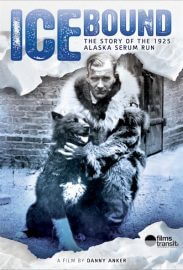
https://www.filmplatform.net/product/icebound
In 1925, diphtheria broke out in Nome, Alaska. With aviation still in its infancy, and one of the harshest winters on record in interior Alaska, only ancient means – dogsled – could save the town.
In temperatures as low as minus 60, more than twenty men, and at least 150 dogs, set out via dogsled to relay the antitoxin across 674 miles of Alaskan wilderness to save the town from the lethal epidemic. A riveting journey back in time, an ageless adventure that has captured the imagination of children and adults (BALTO!) throughout the world for almost a century.

On January 28, 1925, newspapers and radio stations across the nation headlined a terrifying story: Diphtheria had broken out among the children of Nome, Alaska. Nome, a small outpost on the Bering Sea, was as isolated as they come, separated from the rest of the world for seven months each year by a frozen ocean. With barely enough antitoxin on hand to treat half a dozen people, the death toll for Nome and other outlying communities could potentially reach into the thousands.
Soon after the outbreak, a small but precious supply of life-saving serum was located more than 1,000 miles away. With aviation still in its infancy, and one of the harshest winters on record in interior Alaska, only ancient means – dogsled – could save the town.
In temperatures as low as 60 degrees below zero, more than twenty men, and at least 150 dogs, set out via dogsled to relay the antitoxin across 674 miles of Alaskan wilderness to save the town from the lethal epidemic.
But unbeknownst to them, the story had already gone global. It was the dawn of the radio era, and a burgeoning mass media picked up the story just days into the ordeal. A riveted nation eagerly awaited news of the race in the morning and evening editions of their local newspapers. It seemed as if the entire country gathered together for the first time to follow one single story. And it went even further: newspapers in Europe, Russia, and Australia also headlined the daily struggle to save the children of Nome. America – and the world – grew smaller.
Racing around the clock, the serum reached Nome in 127 hours and 30 minutes, a little over five days, and the heroic effort soon was heralded as one of the most legendary feats on the northern frontier. It also produced an American legend – the lead dog ‘Balto,’ who was deified by the press, and who subsequently achieved a level of celebrity surpassing most Hollywood stars.
The “Race Against Death” remains one of the most harrowing cliffhangers of the 20th century—and is often called the “greatest dog story” ever told. But it is not just an adventure story. ICEBOUND will do justice to the larger historical context of the story and its many ironies. In many ways, it is the tensions of the story that make it fascinating and important: the tensions between Alaskan natives and white pioneers, between primitive means and modern technology, between a failure of modernity (the limitations of flight) and its promise (the success of the serum in eradicating disease). No less fascinating is the media circus that resulted, which in many ways was a precursor to the sensationalism of modern journalism. The film will offer an enlightening portrait of America at the threshold of the modern age, enthralled with the romance of the “final frontier.”
The startling news of the Alaska diphtheria epidemic in January 1925 grabbed national headlines precisely because the modern world appeared to be so vastly different from Alaska. The bold contrast between the rugged, pioneer conditions on the Alaskan frontier, and life as it was lived in the “Lower 48,” cast the revolutionary changes of the 1920’s into stark relief. But the publicity also brought progress: The story of the epidemic in Nome, just seven years after the catastrophic 1918 influenza epidemic, became the impetus to eradicate diphtheria nationwide. The triumph of technology over illness helped inspire the conquest of many contagious diseases, including polio. “If the threat of diphtheria now seems quaint,” The New York Times reported many years later, “it is only because the Serum Run brought an end to the disease as a health menace in the United States.”
ICEBOUND is the first feature-length documentary to tell this story. It will include rarely-seen archival footage and feature a range of voices: historians, journalists, mushers, present and former residents of Nome, as well as surviving witnesses to the events of 1925, including elders from the Interior native villages where many of the heroic mushers lived.